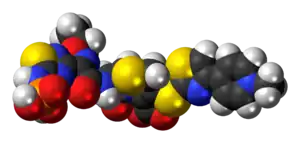Ceftaroline fosamil
 | |
 | |
| Names | |
|---|---|
| Pronunciation | /sɛfˈtæroʊliːn/ |
| Trade names | Teflaro, Zinforo |
| Other names | Ceftaroline, PPI 0903, TAK-599 |
IUPAC name
| |
| Clinical data | |
| Drug class | Cephalosporin[1] |
| Main uses | Skin and soft tissue infections, pneumonia[1][2] |
| Side effects | Diarrhea, nausea, rash, fever[1] |
| WHO AWaRe | UnlinkedWikibase error: ⧼unlinkedwikibase-error-statements-entity-not-set⧽ |
| Pregnancy category |
|
| Routes of use | Intravenous |
| Typical dose | 600 mg BID[3] |
| External links | |
| AHFS/Drugs.com | Monograph |
| MedlinePlus | a611014 |
| Legal | |
| License data |
|
| Legal status | |
| Pharmacokinetics | |
| Protein binding | 20% |
| Elimination half-life | 2.5 hours |
| Excretion | Urine (88%), faeces (6%) |
| Chemical and physical data | |
| Formula | C22H21N8O8PS4 |
| Molar mass | 684.67 g·mol−1 |
| 3D model (JSmol) | |
SMILES
| |
InChI
| |
Ceftaroline fosamil, sold under the brand name Teflaro and Zinforo, is an antibioticused to treat skin and soft tissue infections and pneumonia.[1][2] It is used in difficult to treat cases including those with methicillin-resistant Staphylococcus aureus (MRSA).[2][4] It is given by injection into a vein.[3]
Common side effects include diarrhea, nausea, rash, and fever.[1] Other side effects may include anaphylaxis, Clostridioides difficile infection, and red blood cell breakdown.[1] Well there is no evidence of harm in pregnancy, such use has not been well studied.[5] It is a cephalosporin and works by disrupting the bacterial cell wall.[1][2]
Ceftaroline was approved for medical use in the United States in 2010 and Europe in 2012.[4][2] It was removed from the World Health Organization's List of Essential Medicines in 2019.[6] In the United Kingdom 5 days of treatment costs the NHS about £375 as of 2021.[3] This amount in the United States costs bout 2,200 USD.[7] A generic version was approved in 2021 in the USA.[8]
Medical use
Ceftaroline has activity against MRSA with evidence in complicated skin and skin structure infections with reported non-inferior efficacy against MRSA compared to vancomycin and aztreonam.[9][10] Evidence also supports use in community-acquired pneumonia comparing it against ceftriaxone with non-inferior results and similar side effects.[11][12]
Methicillin-resistant Staph aureus (MRSA) can develop resistance to ceftaroline through the alteration of penicillin-binding proteins. Amino acid-altering mutations in the ceftaroline-binding pocket of the transpeptidase region of penicillin-binding protein 2a (PBP2a) confer resistance to ceftaroline.[13] Ceftaroline-resistant methicillin-resistant strains of Staph aureus have been identified in Europe and Asia, but have not been identified in the United States.[14] While cephalosporinases (a type of beta-lactamase that inactivates cephalosporins) confers resistance to other cephalosporins, cephalosporinases have not yet been identified as a mechanism of resistance to ceftaroline.
Dosage
It is generally given at a dose of 600 mg twice per day.[3] It is often used for 5 to 14 days.[3]
Contraindications
- Known serious hypersensitivity to ceftaroline or other members of the cephalosporin class
- Anaphylaxis and anaphylactoid reactions[15]
Side effects
The clinical studies indicated ceftaroline was well tolerated. The overall rate of adverse events was comparable between the two treatment groups (The CANVAS I and CANVAS II trials evaluated ceftaroline monotherapy versus vancomycin plus aztreonam in adult subjects with complicated skin and skin structure infections caused by Gram-positive and Gram-negative bacteria.). The overall discontinuation rate for ceftaroline-treated subjects was 2.7% compared to a rate of 3.7% for the comparator group-treated subjects. The most common adverse reactions occurring in > 2% of subjects receiving ceftaroline in the pooled phase-III clinical trials were diarrhea, nausea, and rash.[15]
No adverse reactions occurred in greater than 5% of people receiving ceftaroline. The most common adverse reactions occurring in > 2% of people receiving ceftaroline in the pooled phase-III clinical trials were:[15]
Hypersensitivity
Serious hypersensitivity (anaphylactic) reactions and serious skin reactions have been reported with beta-lactam antibiotics, including ceftaroline. Exercise caution in people with known hypersensitivity to beta-lactam antibiotics including ceftaroline. Before therapy with ceftaroline is instituted, careful inquiry about previous hypersensitivity reactions to other cephalosporins, penicillins, or carbapenems should be made. If this product is to be given to penicillin- or other beta-lactam-allergic people, caution should be exercised because cross sensitivity among beta-lactam antibacterial agents has been clearly established. If an allergic reaction to ceftaroline occurs, the drug should be discontinued. Serious acute hypersensitivity reactions require emergency treatment with epinephrine and other emergency measures, that may include airway management, oxygen, intravenous fluids, antihistamines, corticosteroids, and vasopressors as clinically indicated.[15]
Clostridium difficile diarrhea
Clostridium difficile-associated diarrhea (CDAD) has been reported for nearly all antibacterial agents including ceftaroline, and may range in severity from mild diarrhea to fatal colitis. Careful medical history is necessary because CDAD has been reported to occur more than two months after the administration of antibacterial agents. If CDAD is suspected or confirmed, antibacterials not directed against C. difficile should be discontinued, if possible.[15]
Resistant bacteria
Prescribing ceftaroline in the absence of a proven or strongly suspected bacterial infection is unlikely to provide benefit to the patient and increases the risk of the development of drug-resistant bacteria.
It retains some activity of later-generation cephalosporins having broad-spectrum activity against Gram-negative bacteria, but its effectiveness is relatively much weaker.[16][17]
Specific populations
For pregnant or nursing mothers, ceftaroline fosamil should be used only if the potential benefit outweighs the potential risk to the fetus or child. Safety and effectiveness in pediatric children has not been studied.
Because elderly people 65 years of age or older are more likely to have decreased renal function and ceftaroline is excreted primarily by the kidney, care should be taken in dose selection in this age group as in younger people with impaired renal function. Dosage adjustment is required in people with moderately (30 to ‰¤ 50 mL/min) or severely (< 30 mL/min) impaired renal function.
The pharmacokinetics of ceftaroline in people with hepatic impairment have not been established.
Interactions
No clinical drug-drug interaction studies have been conducted with ceftaroline fosamil. In vitro studies in human liver microsomes indicated that neither ceftaroline fosamil nor ceftaroline inhibits the major cytochrome P450 isoenzymes. Therefore, neither ceftaroline fosamil nor ceftaroline is expected to inhibit or induce the clearance of drugs that are metabolized by these metabolic pathways in a clinically relevant manner.
Direct Coombs test
In the pooled phase-III CABP trials, 51/520 (9.8%) of subjects treated with ceftaroline compared to 24/534 (4.5%) of subjects treated with ceftriaxone seroconverted from a negative to a positive direct Coombs' test result. No clinical adverse reactions representing hemolytic anemia were reported in any treatment group. If anemia develops during or after treatment with ceftaroline, drug-induced hemolytic anemia should be considered. If drug-induced hemolytic anemia is suspected, discontinuation of ceftaroline should be considered and supportive care should be administered to the patient if clinically indicated.
Chemistry
Ceftaroline fosamil is used in form of the acetate. It is a prodrug that is converted to active metabolite ceftaroline and inactive metabolite ceftaroline-M1. Initial in vitro and in vivo animal studies referred to ceftaroline fosamil acetate as PPI-0903.[18][19]
Characteristic of cephalosporins, ceftaroline has a bicyclic ring with four-member β-lactam ring fused to a six-member cephem ring. Ceftaroline is thought to have activity against MRSA with its 1,3-thiazole ring.[20]
History
Ceftaroline is being developed by Forest Laboratories, under a license from Takeda.[21]
Research
It is currently being investigated for community-acquired pneumonia[11] and complicated skin and skin structure infection.[9][10][21]
References
- 1 2 3 4 5 6 7 8 "Teflaro- ceftaroline fosamil powder, for solution". DailyMed. 24 September 2019. Archived from the original on 18 January 2021. Retrieved 1 March 2020.
- 1 2 3 4 5 6 "Zinforo EPAR". European Medicines Agency (EMA). Archived from the original on 12 July 2019. Retrieved 1 March 2020.
- 1 2 3 4 5 BNF 81: March-September 2021. BMJ Group and the Pharmaceutical Press. 2021. p. 562. ISBN 978-0857114105.
- 1 2 "Ceftaroline Monograph for Professionals". Drugs.com. Archived from the original on 23 January 2021. Retrieved 1 January 2022.
- ↑ "Ceftaroline (Teflaro) Use During Pregnancy". Drugs.com. Archived from the original on 28 November 2020. Retrieved 2 January 2022.
- ↑ World Health Organization (2019). Executive summary: the selection and use of essential medicines 2019: report of the 22nd WHO Expert Committee on the selection and use of essential medicines. Geneva: World Health Organization. hdl:10665/325773. WHO/MVP/EMP/IAU/2019.05. License: CC BY-NC-SA 3.0 IGO.
- ↑ "Teflaro Prices, Coupons & Patient Assistance Programs". Drugs.com. Archived from the original on 11 November 2020. Retrieved 2 January 2022.
- ↑ Research, Center for Drug Evaluation and (10 February 2022). "2021 First Generic Drug Approvals". FDA. Archived from the original on 21 June 2022. Retrieved 22 October 2022.
- 1 2 R, Corey; Wilcox M; Talbot GH; et al. CANVAS-1: Randomized, Double-blinded, Phase 3 Study (P903-06) of the Efficacy and Safety of Ceftaroline vs. Vancomycin plus Aztreonam in Complicated Skin and Skin Structure Infections (cSSSI). 2008 Interscience Conference on Antimicrobial Agents and Chemotherapy / Infectious Disease Society of America Conference.
- 1 2 Kanafani ZA, Corey GR (February 2009). "Ceftaroline: a cephalosporin with expanded Gram-positive activity". Future Microbiology. 4 (1): 25–33. doi:10.2217/17460913.4.1.25. PMID 19207097.
- 1 2 P, Eckberg; Friedland HD; et al. FOCUS 1 and 2: Randomized, Double-blinded, Multicenter Phase 3 Trials of the Efficacy and Safety of Ceftaroline (CPT) vs. Ceftriaxone (CRO) in Community-acquired pneumonia (CAP). 2009 Interscience Conference on Antimicrobial Agents and Chemotherapy / Infectious Disease Society of America Conference.
- ↑ "New Drug Approvals". 29 October 2010. Archived from the original on 29 August 2021. Retrieved 8 November 2010.
- ↑ Long SW, Olsen RJ, Mehta SC, et al. PBP2a mutations causing high-level Ceftaroline resistance in clinical methicillin-resistant Staphylococcus aureus isolates. Antimicrob Agents Chemother. 2014;58(11):6668-6674. doi:10.1128/AAC.03622-14
- ↑ Long SW, Olsen RJ, Mehta SC, et al. PBP2a mutations causing high-level Ceftaroline resistance in clinical methicillin-resistant Staphylococcus aureus isolates. Antimicrob Agents Chemother. 2014;58(11):6668-6674. doi:10.1128/AAC.03622-14
- 1 2 3 4 5 "Teflaro". 29 October 2010. Archived from the original on 18 July 2017. Retrieved 8 November 2010.
- ↑ Karlowsky, James (December 2010). "In Vitro Activity of Ceftaroline against Gram-Positive and Gram-Negative Pathogens Isolated from Patients in Canadian Hospitals in 2009". Antimicrob Agents Chemother. 55 (6): 2837–46. doi:10.1128/aac.01787-10. PMC 3101400. PMID 21402844.
- ↑ Flamm, Robert (October 2010). "Spectrum and potency of ceftaroline against leading pathogens causing community-acquired respiratory tract and skin and soft tissue infections in Latin America, 2010". Braz J Infect Dis. 17 (5): 564–72. doi:10.1016/j.bjid.2013.02.008. PMID 23916453.
- ↑ Y, Ge; Floren L; Redman R; et al. The pharmacokinetics and safety of ceftaroline (PPI-0903) in healthy subjects receiving multiple-dose intravenous infusions. 2006 Interscience Conference on Antimicrobial Agents and Chemotherapy / Infectious Disease Society of America Conference.
- ↑ Yukihiro I, Junko B (2008). "Stability and Stabilization Studies of TAK-599 (Ceftaroline Fosamil) a Novel N-Phosphono Type Prodrug of Anti-methicillin Resistant Staphylococcus aureus Cephalosporin T-91825". Chem Pharm Bull. 56 (10): 1406–11. doi:10.1248/cpb.56.1406. PMID 18827379.
- ↑ Ishikawa t; Nobuyuki M; et al. (2003). "TAK-599, a novel N-phosphono type prodrug of anti-MRSA cephalosporin T-91825: Synthesis, physicochemical and pharmacological properties". Bioorg Med Chem. 11 (11): 2427–2437. doi:10.1016/s0968-0896(03)00126-3. PMID 12735989.
- 1 2 Parish D, Scheinfeld N (February 2008). "Ceftaroline fosamil, a cephalosporin derivative for the potential treatment of MRSA infection". Current Opinion in Investigational Drugs. 9 (2): 201–9. PMID 18246523.
External links
| Identifiers: |
|---|
- "Ceftaroline fosamil". Drug Information Portal. U.S. National Library of Medicine. Archived from the original on 2 March 2020. Retrieved 28 August 2021.